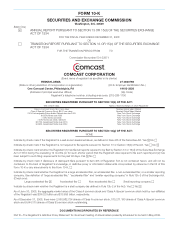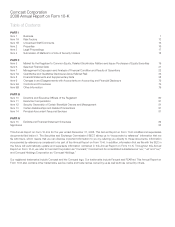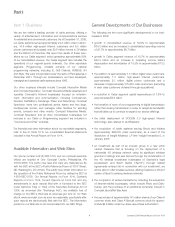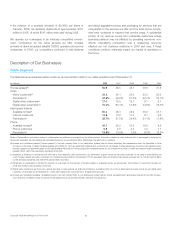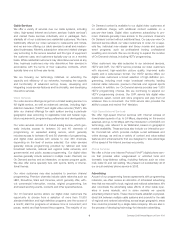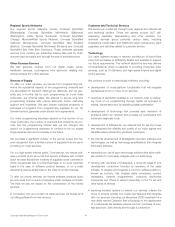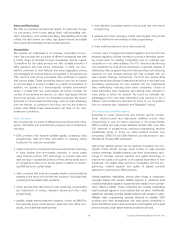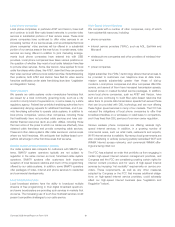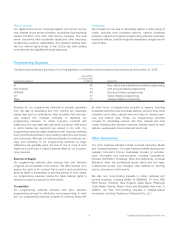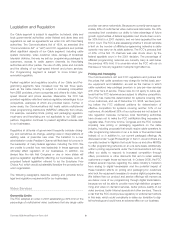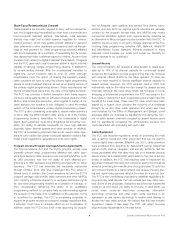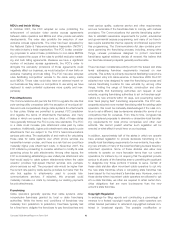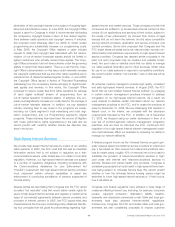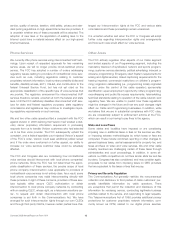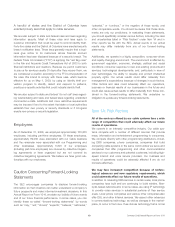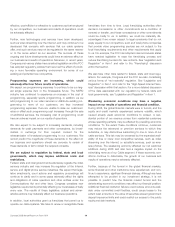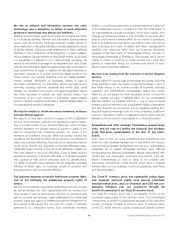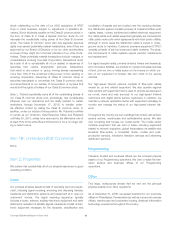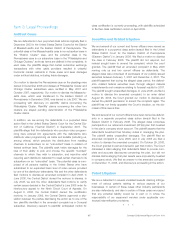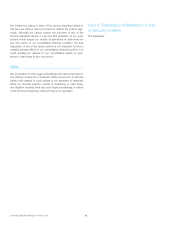Comcast 2008 Annual Report Download - page 10
Download and view the complete annual report
Please find page 10 of the 2008 Comcast annual report below. You can navigate through the pages in the report by either clicking on the pages listed below, or by using the keyword search tool below to find specific information within the annual report.
Legislation and Regulation
Our Cable segment is subject to regulation by federal, state and
local governmental authorities under federal and state laws and
regulations as well as agreements we enter into with franchising
authorities. The Communications Act of 1934, as amended (the
“Communications Act” or “Act”) and FCC regulations and policies
affect significant aspects of our Cable segment, including cable
system ownership, video customer rates, carriage of broadcast
television stations, the way we sell our programming packages to
customers, access to cable system channels by franchising
authorities and other parties, the use of utility poles and conduits
and the offering of our high-speed Internet and phone services.
Our Programming segment is subject to more limited gov-
ernmental regulation.
Federal regulation and regulatory scrutiny of our Cable and Pro-
gramming segments have increased over the last three years,
even as the cable industry is subject to increasing competition
from DBS providers, phone companies and others for video, high-
speed Internet and phone services. Meanwhile, the FCC has
provided regulatory relief and various regulatory advantages to our
competitors, examples of which are provided below. Further, in
some areas, the Communications Act treats certain multichannel
video programming distributors (“MVPDs”) differently from others.
For example, ownership limits, pricing and packaging regulation,
must-carry and franchising are not applicable to our DBS com-
petitors. Regulation continues to present significant adverse risks
to our businesses.
Regulators at all levels of government frequently consider chang-
ing, and sometimes do change, existing rules or interpretations of
existing rules, or prescribe new ones. The transition to a new
administration under President Obama will likely lead to turnover in
the leadership of many federal agencies, including the FCC. We
are unable to predict how new leadership in these agencies will
ultimately affect regulation of our businesses. In addition, we
always face the risk that Congress or one or more states will
approve legislation significantly affecting our businesses, such as
proposed federal legislation referred to as the Employee Free
Choice Act, which would substantially liberalize the procedures for
union organization.
The following paragraphs describe existing and potential future
legal and regulatory requirements for our businesses.
Video Services
Ownership Limits
The FCC adopted an order in 2007 establishing a 30% limit on the
percentage of multichannel video customers that any single cable
provider can serve nationwide. Because we currently serve approx-
imately 26% of multichannel video customers nationwide, the 30%
ownership limit constrains our ability to take advantage of future
growth opportunities. A federal appellate court struck down a sim-
ilar 30% limit in a 2001 decision, and we have appealed the new
limit in court. The FCC is also assessing whether it should reinstate
a limit on the number of affiliated programming networks a cable
operator may carry on its cable systems. The FCC’s previous limit
of 40% of the first 75 channels was also struck down by the
federal appellate court in the 2001 decision. The percentage of
affiliated programming networks we currently carry is well below
the previous 40% limit. It is uncertain when the FCC will rule on
this issue or how any regulation it adopts might affect us.
Pricing and Packaging
The Communications Act and FCC regulations and policies limit
the prices that cable operators may charge for limited basic serv-
ice, equipment and installation, as well as the manner in which
cable operators may package premium or pay-per-view services
with other tiers of service. These rules do not apply to cable sys-
tems that the FCC determines are subject to effective competition.
The FCC has made this determination for systems covering 33%
of our customers, and, as of December 31, 2008, we have pend-
ing before the FCC additional petitions for determination of
effective competition for systems covering another 12% of our
customers. An additional 35% of our customers are not subject to
rate regulation because numerous local franchising authorities
have chosen not to make the FCC certification filing necessary to
regulate rates. From time to time, Congress and the FCC consider
imposing new pricing or packaging regulations on the cable
industry, including proposals that would require cable operators to
offer programming networks on an a la carte or themed-tier basis
instead of, or in addition to, our current packaged offerings. As
discussed under “Legal Proceedings” in Item 3, we and others are
currently involved in litigation that could force us and other MVPDs
to offer programming networks on an a la carte basis. Additionally,
uniform pricing requirements under the Communications Act may
affect our ability to respond to increased competition through
offers, promotions or other discounts that aim to retain existing
customers or regain those we have lost. In October 2008, the FCC
initiated several inquiries regarding the cable industry’s transition
from analog to digital transmission and the potential impact of
these transition efforts on pricing and packaging for customers
who lack the equipment necessary to receive digital programming.
We believe that our product and service offerings will improve as
we deliver more of our programming through digital transmission,
because we will be able to provide more high-definition program-
ming and video on demand services, better picture quality of our
video services, faster Internet speeds and other services. There is
a risk that the FCC could pursue regulatory or enforcement actions
in this area, which could complicate or delay our transition to digi-
tal technology and could have an adverse effect on our business.
Comcast 2008 Annual Report on Form 10-K 8

